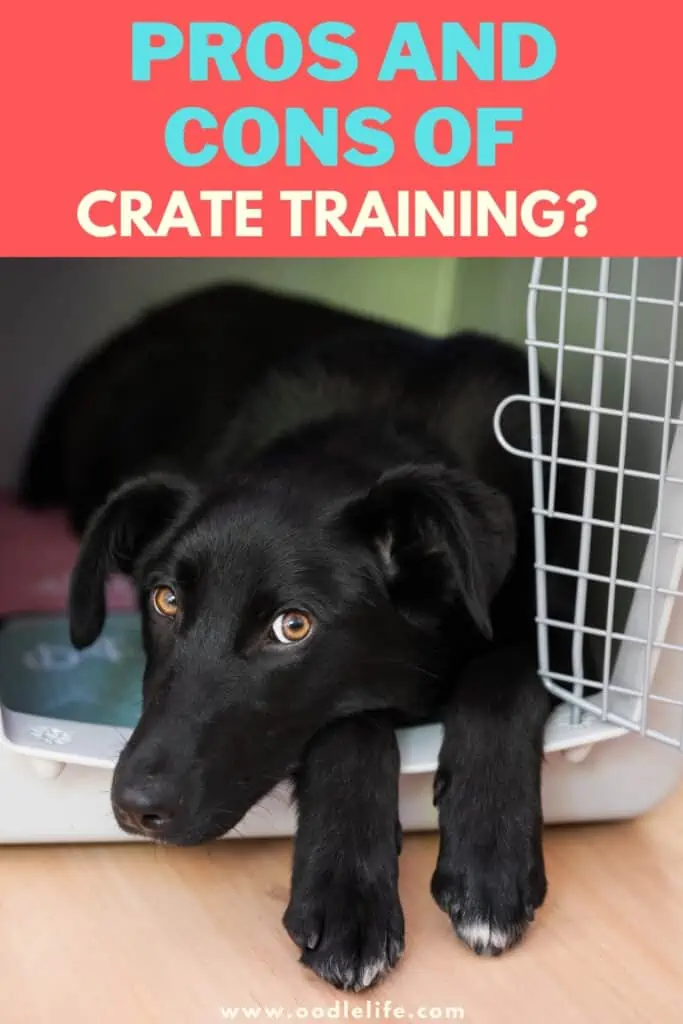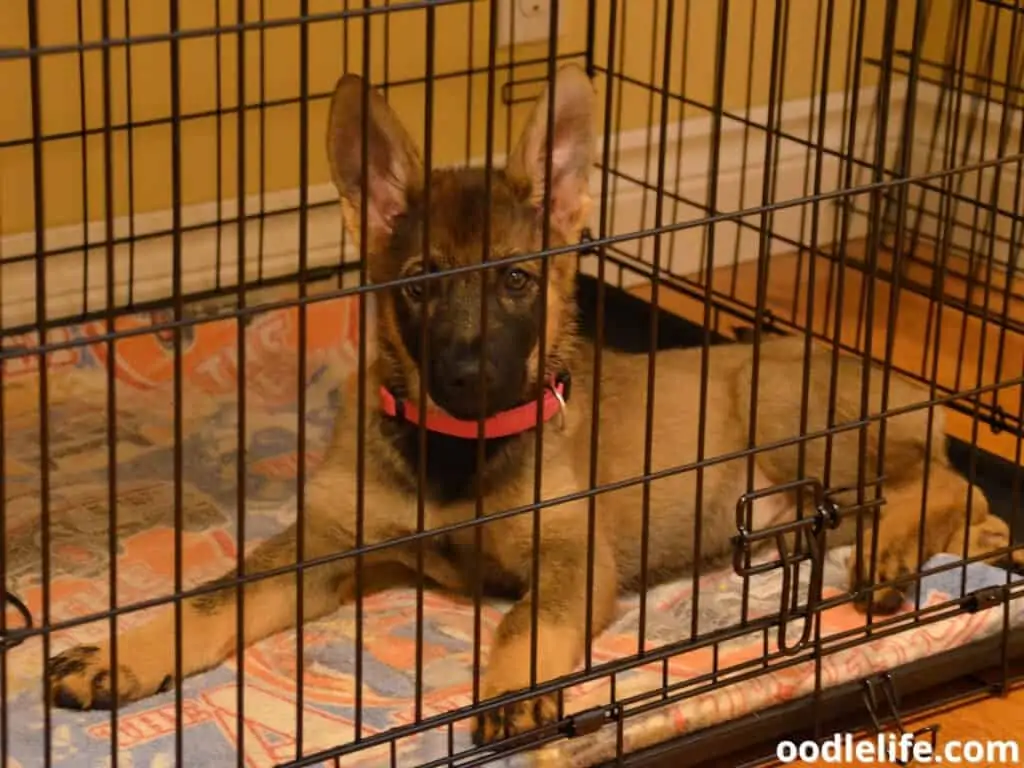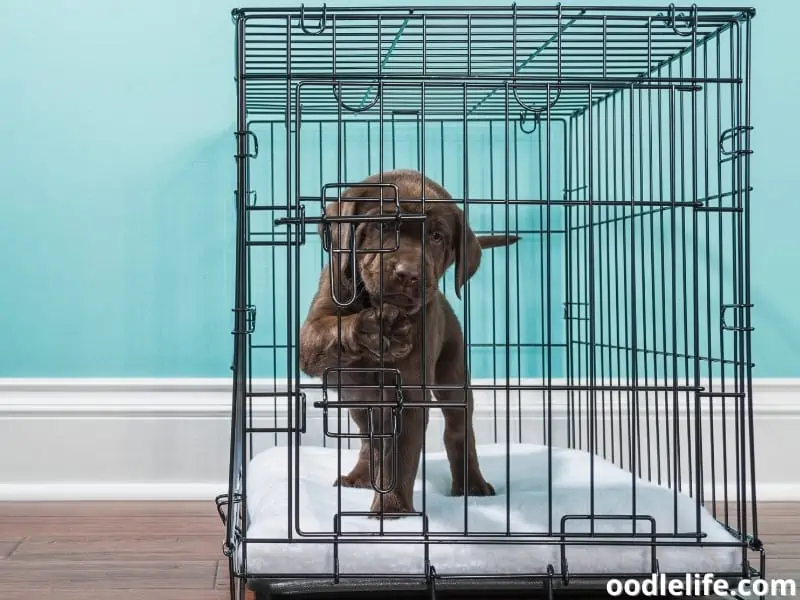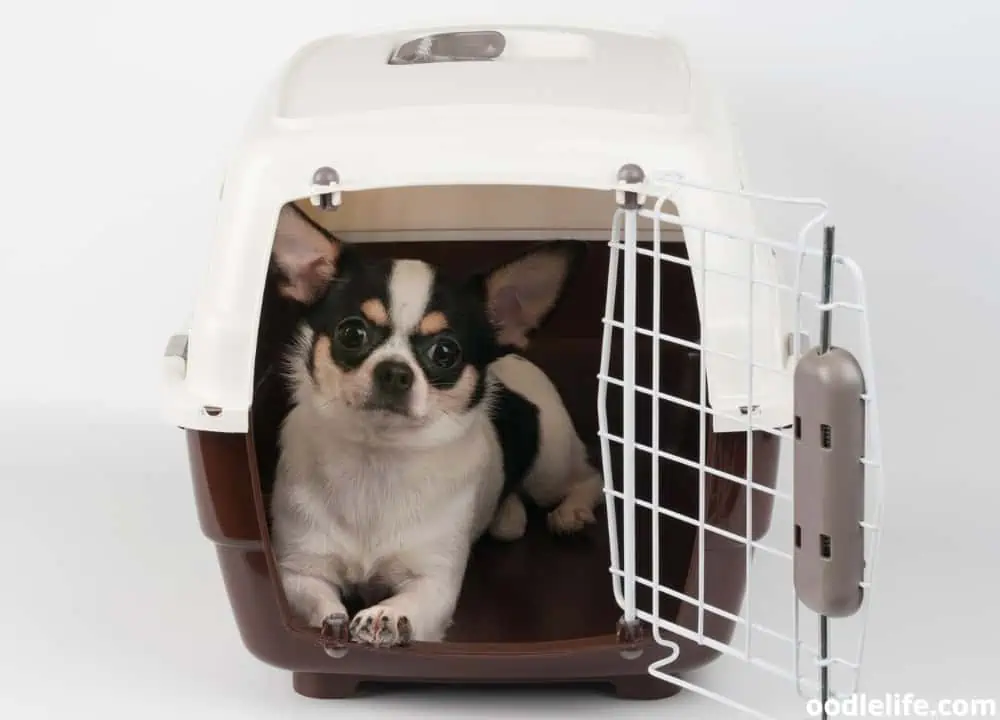Pros and Cons of Crate Training [How To Decide]
When I was a first-time dog owner (many years ago) I was surprised at how many people asked if I would crate train.
Friends, family, and my Vet asked if I planned to – and admittedly, at the time I had no plans to do so since my dog was basically already house trained despite his young age.
After a few discussions with those same folks, I decided it was in my apartment-dwelling and future service dog’s best interest to dive in and embrace the crate training lifestyle.
Since then I have become a strong advocate of crate training for myself and my dog training clients.

After a few days of working with my dog to get him comfortable in his crate for about 2-3 minutes at a time I jumped the gun and decided that I would crate my dog for about 10 minutes as I walked down to the corner store for a donut with my roommate.
As we approached the apartment building on the way back we heard frantic near non-stop yelping and barking from deep in the building somewhere. I paused mid-bite, made eye contact with my roommate as my eyes got wide and we quickly scurried back up to a very loudly opinionated dog, unharmed and still in his crate, but under more stress than I was hoping for in such a short time left alone.
Thankfully, I had very kind neighbors and an even kinder friend with experience crate training dozens of dogs that I asked to help us get back on track. With her help and a few days of my dog learning from her already crate trained Yorkie, we were able to find success in the crate and I am very glad that my dog has the knowledge now… But those first few days were rough!
Weigh up the Pros and Cons for Dog AND Owner

Before you make the same mistake that I did, take a look at some of the advantages and disadvantages to crate training – and hopefully, whether you decide to crate train or not, you’ll have a safe and positive training experience going forward.
Crates might not be right for every dog and that’s perfectly ok!
| Pros for the dogs | Pros for the humans | Cons for the dogs | Cons for the humans |
| Den-like space that many dogs instinctively look for | Crated transport is often easier and safer | Collars, leashes and clothing can be a safety hazard | Dogs cannot be crated for more than a few hours at a time |
| Familiar space to retreat to in times of stress like moving, thunder, vacuuming | Potty training can be simplified using a crate | Initial training can be very frustrating | Crate training takes time and consistency over weeks to months |
| Helps them to cope when crated at the vet or groomer | Dogs may be more likely to sleep in their crate and off the furniture | A panicked dog can quickly injure themselves trying to escape | Crates can be an eyesore in the home |
| Can improve separation anxiety | Travel accommodations are more likely to allow crated dogs to stay | Some dogs may feel the need to guard their crate from other dogs or people | Guarding behavior can scare or cause injury to humans, kids, or other pets |
| Dogs with health issues or limited mobility may greatly benefit from having daily crate time | Dogs can be safely restrained in a calm manner when company is over | Extremely anxious dogs may eat mats, trays or chew on the crate which could damage teeth or internal organs | Unknowing kids may try to sit in the crate with a dog which puts them at risk for bite or other injury. |
After taking a look at the advantages and drawbacks if you still think that you and your 4-legged friend are ready to tackle crate training, keep reading for some helpful tips we pulled together from professionals and dog experts to keep your training positive, safe, and hopefully a little quieter than my first foray into crate training.

Avoiding Safety Issues And Stress For Your Pup:
Start slow with only a few seconds of having the crate door shut at a time and work every day over the course of weeks to months to build your dog’s capacity for staying in the crate. Crating for more than 3-4 hours each day is unfair and can even be cruel.
If you can’t be home to let your dog out for mental and physical stimulation during the day you’ll want to hire a dog walker or sitter for part of the day to avoid problems.
Before buying a crate you will want to consider the size of your dog right now – not what they will look like in 6 months. A too-large crate might encourage your dog to soil inside the crate and set back potty training efforts. One that is too small and you risk joint damage, behavioral issues, and other mental stress.

Puppies should be kept in puppy-sized crates and upgraded to more room as they grow to their full size and are regularly pottying outside. Some crates on the market even have dividers that come with the crate and can be used to portion off smaller parts of a larger crate which allow you to adjust it as your pup grows to their full size.
Remove collars, leashes, harnesses, or dog clothing before leaving any dog unattended in a crate. They can quickly get caught and risk strangulation or other injury so it’s best to leave them in their birthday suits when crated, even if they are seasoned crate-veterans.
Think about the temperature of where your crate is all day. Crates that get sun for much of the day may become too warm and many crates on the market don’t offer adequate ventilation to cool off the space.
On the other hand, leaving a crate in an area of your home that gets too cold can be equally as harmful. Consider their breed as well – a Husky or St. Bernard might love the coolness of your garage while a Chihuahua would likely enjoy a warmer area toward the middle of the house.

Stay Positive!
Keep it positive! Training for crate time should be a calm and fun experience for your pup. Never use the crate for punishment, think of the crate as your dog’s Zen place to enjoy naps, chews or to say “I’ve had enough socializing and want to be left alone.”
On the same thought – crates should be in a quiet and calm area of the home. Children’s play rooms, kitchens, or busy gaming rooms and hallways would make a poor choice for a crate.
A calm living room, bedroom, or office might be a better spot.
Many dog owners find it convenient and safer to feed dogs, especially if there are multiple in the home, inside the crates. This ensures that they not only eat all of their own food. It also can help prevent food aggression problems between dog-siblings and even gives your dog excitement and positive associations with the crate.
This is very important for long-term success of this training.

Avoid touching or trying to play with your dog when they are crated. If you have kids in the home it’s important for them to understand that they should never to crawl into the crate with your dog, no matter how well behaved they are with the kids.
Does your dog have separation anxiety? Crate training might be your key to successfully reducing their stress.
Researchers with the American Veterinary Medical Association examined methods to reduce anxiety in dogs and found that nearly ⅔ of the 57 dogs in the study showed improvement in their separation anxiety after learning to be crated for some portions of the day.
Ultimately I chose to crate train to improve my dog’s separation anxiety, and to keep him from getting into the trash and laundry when I wasn’t home.
Now, as a service dog, he is able to confidently be left alone without supervision for much of the day without anxious behavior like barking, yelping or chewing which is critical to his success as my service dog.
The method that my friend showed me and that we had success with included using lots of high reward treats, encouraging use of the crate with the door open during down time when my dog was naturally sleepy after play or meal times, and providing a long lasting chew or lick toy like a frozen peanut butter filled toy right before I left the house.
Crating surely is not a one size fits all solution to behavior problems but If you’re like me and after considering the advantages and drawbacks, you do decide that you want to crate train, I highly recommend you reach out to a professional trainer or someone else experienced in crate training before diving in for the first time.
It will save your dog a fair bit of stress and hopefully save you and your neighbors from the barking-induced headache I gave mine!
Best of luck and happy training!
